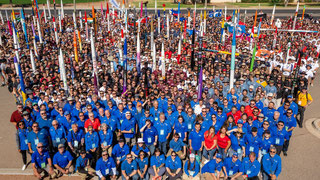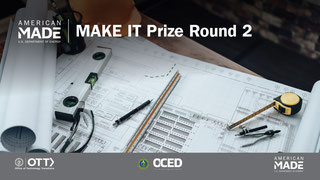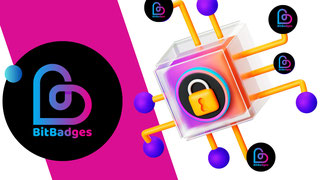Image Credit: Sung Wha Kang (RISD), CC BY-ND
Between the Earth and the moon: An artist’s rendering of a refueling depot for deep-space exploration.
This is a US competition only. Please review the Guidelines and Legal Agreement for complete eligibility requirements.
Cryogenic fluids (LOX and LH2 in this context) have been used in spaceflight launch vehicles since the Gemini era. During the short duration of a launch, losses of cryogenic fluids due to boil off and leakage have been acceptable trade-offs for mission performance. Using the current state of the art, cryogenic fluid storage in an operational field (in-space propellant depot or tank storage in situ) is limited to several weeks. Future human space missions will have a duration of months to years and will require consumable losses to be minimal during long term in-space transportation, depot storage, and transfer between tanks.
Describe an innovation that can improve the use of cryogenic fluid management (CFM) in support of extended duration human spaceflight. The proposed innovation can be new technology or a novel use of existing technology. This challenge is seeking improvements to materials, manufacturing techniques, processes, or improvements to components or systems involved in CFM.
Overview
Cryogenic fluids (LOX and LH2 in this context) have been used in spaceflight launch vehicles since the Gemini era. During the short duration of a launch, losses of cryogenic fluids due to boil off and leakage have been acceptable trade-offs for mission performance. Using the current state of the art, cryogenic fluid storage in an operational field (in-space propellant depot or tank storage in situ) is limited to several weeks. Future human space missions will have a duration of months to years and will require consumable losses to be minimal during long term in-space transportation, depot storage, and transfer between tanks.
Describe an innovation that can improve the use of cryogenic fluid management (CFM) in support of extended duration human spaceflight. The proposed innovation can be new technology or a novel use of existing technology. This challenge is seeking improvements to materials, manufacturing techniques, processes, or improvements to components or systems involved in CFM.
Key Cryogenic Fluid Management Technologies
- Components
- Filling
- Gauging
- Leak Detection
- Liquid Acquisition
- Mixing Destratification
- Pressurization
- Refrigeration
- Sloshing
- Thermal Control
- Venting
Process
- Interested teams will submit a One Page Abstract describing their concept and projected results
- Teams submitting the best abstracts will be invited to submit a Five Page Proposal
- The top several proposals will present via Video Conference with the winner being chosen from these finalists
Eligibility
- The challenge is limited to US Citizens only.
- Employees of Jacobs, NASA, and others who work on the Jacobs Space Exploration Group (JSEG) Engineering and Science Services Capability Augmentation (ESSCA) contract are not eligible to participate.
Guidelines
- Jacobs and its evaluation committee are solely responsible for the evaluation and selection of challenge winners.
- The submitted ideas shall not contain classified, International Traffic in Arms Regulations (ITAR) or Sensitive But Unclassified (SBU) data. Entrants must certify that all information used is taken from the public domain, generated by the team, or that the team has rights to any data utilized to prepare the proposal.
- Entrants agree that Jacobs shall have the right to publicize the award, including photographs, video, and brief summaries of the idea.
Prize
This challenge will award one prize of $10,000 which will be paid to the designated captain of the winning team; distribution among the team participants is the responsibility of the team captain. Taxes will not be withheld, any tax obligation will be the responsibility of the winning team members.
Timeline
- Open to submissions: May 27, 2021
- One page abstract submission deadline: August 16, 2021 at 9 a.m. (CDT)
- One page abstract finalists notified: August 23, 2021
- Five page proposal submission deadline: September 20, 2021 at 9 a.m. (CDT)
- Five page proposal finalists notified: October 1, 2021
- Video Conferences with finalists: October 18 - 22, 2021
- Winner Announced: October 29, 2021
Judging Criteria
- Innovative (30%) - Does the idea present a unique or innovative approach to solving a problem? The proposal should succinctly describe the uniqueness and benefits of the proposed idea relative to the current state-of-art or alternate approaches.
- Impact (20%) - Is there a likelihood of making a significant contribution toward a critical aspect of human spaceflight? The proposal should provide a description of the impact of the proposed development on NASA missions or objectives.
- Feasibility (25%) - Is there a credible plan/path for implementation into the spaceflight program?
- Technical Approach (25%) - Does the idea demonstrate a high level of technical merit and is it grounded in sound scientific or engineering principles?
The One Page Abstract
The one page abstract should contain the following (to be entered into the HeroX submission form):
- The approximate TRL (Technology Readiness Level) of your innovation. See https://www.nasa.gov/pdf/458490main_TRL_Definitions.pdf
- The problem your technology aims to solve and how it will significantly enhance at least one critical aspect of human spaceflight (safety, affordability, schedule, capability). This should contain 2,000 characters or less.
- Your technology, it's underlying principles of operation, and how it can be integrated into existing systems to significantly enhance human spaceflight. This should contain 3,400 characters or less.
The Five Page Proposal
Teams selected to proceed to the five page proposal stage should include the following sections in the PDF document submitted:
- Executive Summary
- State of the art overview
- Detailed technical explanation of proposed technology with supporting data
- Current level of technical readiness (TRL) and supporting explanation
- Explanation of how your proposal will significantly impact at least one critical aspect of human spaceflight (safety, affordability, schedule, capability)
Additional information on the five page proposal:
- Team member bios and resumes may be included and should be limited to 1 page per person. They do not count toward the 5 page limit.
- References should be in an appendix. They do not count toward the 5 page limit.
- Documents should be submitted in PDF format.
- Minimum font size is 12 pt.
- Please title your document “(Proposal Title)_SpaceTechChallenge_2021”
The Video Conference
- 10 minute presentation
- 10 minute question and answer session
- Submit the slide package for the presentation in either PowerPoint or PDF format








